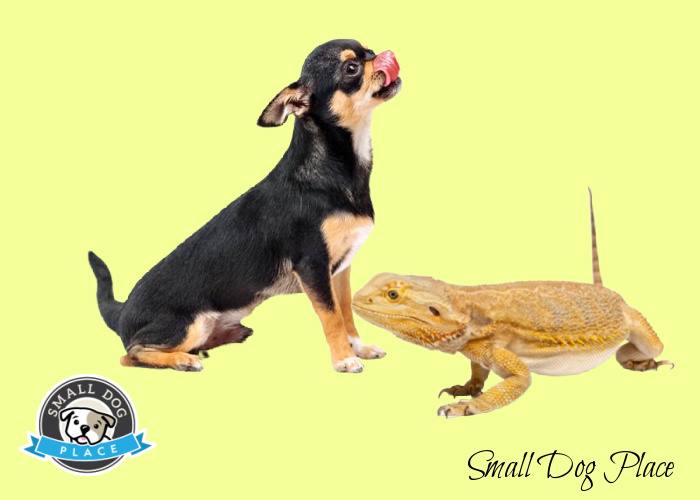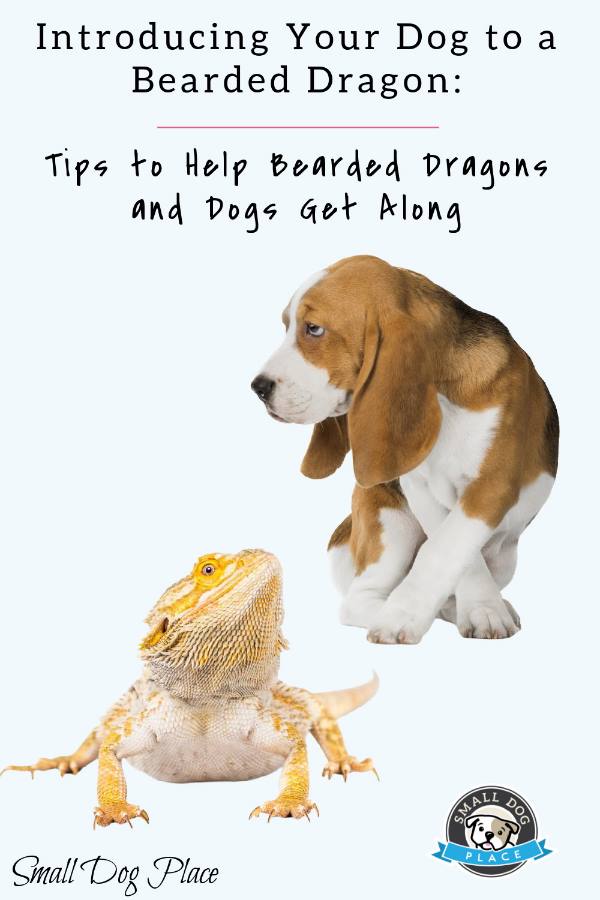- Small Dog Place Home
- Lifestyle
- Bearded Dragons and Dogs
Introducing Your Dog to a Bearded Dragon: Tips to Help Bearded Dragons and Dogs Get Along
Bearded Dragons and Dogs |Published 9-30-2021
Gone are the days when dogs were considered the ideal house pet. Bearded dragons, also lovingly called beardies, are increasingly becoming popular in the household pet scene.
These miniature dragons are extremely friendly and are great cuddle-lovers, making it very convenient to take care of them in a home environment.
Although it is suggested to keep them away from similar species due to their tendency to get into fights, prior track records have shown they can bond pretty well with a dog.
Upon introduction, if abrupt, a dog might not welcome a bearded dragon with open paws. However, this is totally understandable as there is too much of a difference between the two species.
Proper preparation and continued patience from the owner can help the creatures develop a beautiful bond with each other. This article discusses the key steps to take in order to safely introduce a dog to a bearded dragon.

Tips to Help Bearded Dragons and Dogs Live Together
Get Your Dog Accustomed to Reptiles
If you are planning on introducing a bearded dragon to your dog, make sure it does not come as a surprise.
The dog should be aware of how reptiles look and smell for the ice-breaking to go smoothly. If not, the beardie may scare the dog.
A casual walk down to the local pet store should be enough for your dog to sniff through all the vivariums containing an array of different reptiles. Observe your dog’s behavior in front of a bearded dragon.
If it barks or tries to scratch at the beardie’s habitat, know that it still requires time to adjust itself to the idea of having a dragon around.
Paying regular visits to the pet store can gradually ease your dog’s demeanor and finally enable you to bring a bearded dragon into your home.
Know Your Dog’s Mannerisms
The biggest risk associated with introducing a dog to a beardie is the dog’s volatile behavior. Most canines tend to respond very differently to different circumstances.
As the owner, you have to be aware of its varying temperament and appropriately introduce the beardie. Try to predict how the dog might react before letting it see the dragon for the first time.
The anxiety runs on both sides. Bearded dragons tend to puff up their beards—hence the name—when facing potential adversity.
If you see your new beardie reacting this way, take it away from the dog until you feel it is ready to try again. The process takes a lot of time and effort but is eventually rewarding if done right.
Try giving treats to your beardie if it starts getting antsy in front of a dog. TopFlight Dubia roaches are largely considered the best in the business. These feeder insects are highly nutritious for bearded dragons and are, arguably, their favorite food.
Hence, placing a dubia roach in front can divert its attention away from the dog. You can try the same method with your dog as well. Just make sure you give it a dog treat instead of a roach!
Introduce Them in a Neutral, Isolated Environment
Dogs are territorial creatures who do not particularly like the idea of some other animal invading their personal space. Certain dogs have behavioral problems that need to be attended to before introducing a foreigner into their territory.
Hence, the smart thing to do is to bring them together in a neutral location. This way, the dog will not be agitated upon witnessing a foreign creature. Try doing this in the room that the dog visits the least. Your home office or study room can be an ideal location.
As for installing the beardie habitat, we suggest keeping it away from the places where the dog visits the most. Continue to do this for as long as your dog takes to get completely accustomed to the new member of the family. Generally, this does not take long, as dogs will begin to bond with the dragon after a few weeks.
Know the Risks Involved
Dogs are significantly larger in size than an average bearded dragon. Thus, there is a chance that the dog may hurt the beardie even if it is just trying to play. Run a quick search online, and you will be bombarded with stories of dogs severely injuring or killing bearded dragons while attempting to play with them.
Owners have to take charge in such circumstances. They need to constantly monitor the situation whenever the two creatures come into contact and interrupt whenever things start to go wrong. If the conditions do not improve after several weeks of trying, the animals should be separated and kept that way.
Secure the Beardie Tank Properly
Despite your best efforts of carefully controlling their exposure, an unsecured vivarium may lead the bearded dragon to escape. In case this happens, all kinds of problems could be the result. The dog may come in contact with the beardie and harm it. Escape from the house is also a possibility.
Try placing the beardie habitat in an elevated location so that the dog would have a tough time reaching it.
Additionally, as mentioned earlier in this article, keep the container in a room least visited by the dog, at least during the initial weeks.
The safety of these animals—especially the beardie—depends on how focused you are and the amount of effort you put into their continued development.
Final Thoughts
Doing fun things with your dog can be highly rewarding. Make no mistake: the same can be done having a third member—the beardie—in the gang. We believe this article has clearly described all the steps that should be taken in order to build an everlasting friendship between bearded dragons and dogs.
Bearded Dragons and Dogs: Pin for Future Reference
About Janice (author and voice behind this site)
Having lived with dogs and cats most of her life, Janice served as a veterinary technician for ten years in Maryland and twelve years as a Shih Tzu dog breeder in Ohio.
Her education includes undergraduate degrees in Psychology with a minor in biology, Early Childhood Education, and Nursing, and a master's in Mental Health Counseling.
She is a lifelong learner, a dog lover, and passionate about the welfare of animals. Her favorite breed for over 50 years has been the Shih Tzu, but she has also lived with Poodles, Maltese, Yorkshire Terriers, Beagles, English Bulldogs, Carin Terriers, and a Cocker Spaniel.
When not writing, reading, and researching dog-related topics, she likes to spend time with her eight Shih Tzu dogs, husband, and family, as well as knitting and crocheting. She is also the voice behind Miracle Shih Tzu and Smart-Knit-Crocheting
Does This Article Deserve Your Thumbs Up?
We always appreciate your support and encouragement. Your thumbs up means so much to us. Please like this article.
If you find this page or any page on Small Dog Place Helpful, or useful in anyway, I'd love it if you would click the small heart found on the bottom right of each page.
You can also share or bookmark this page -- just click on the:

Free Monthly Newsletter
Sign Up for Our Free Newsletter and get our Free Gift to You.
my E-book, The Top 10 Mistakes People Make When Choosing a Dog (and how to avoid them)


